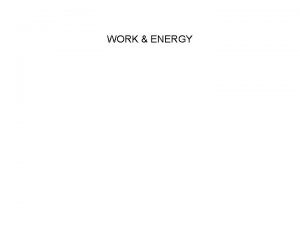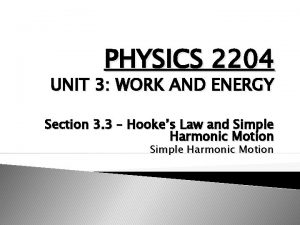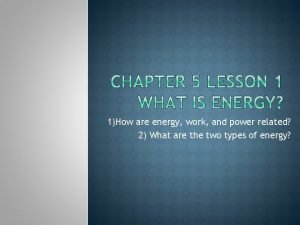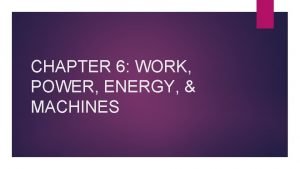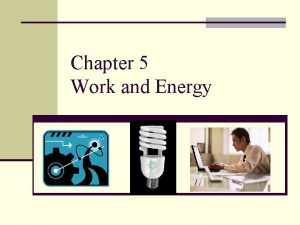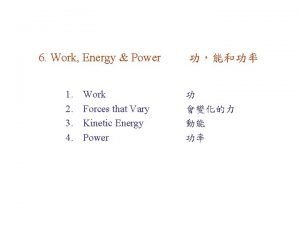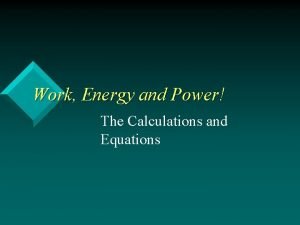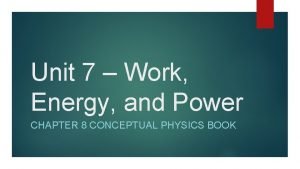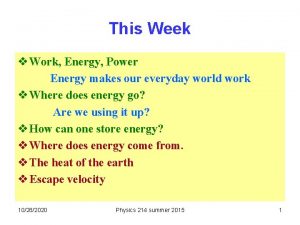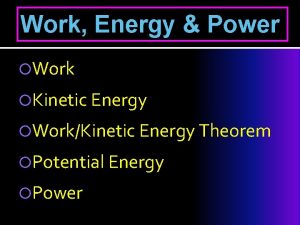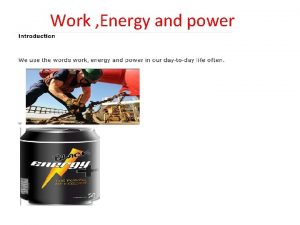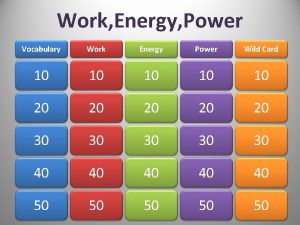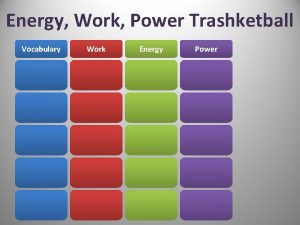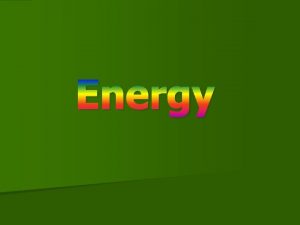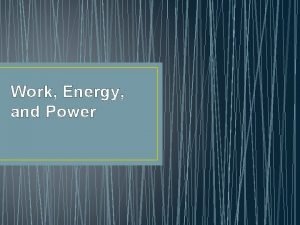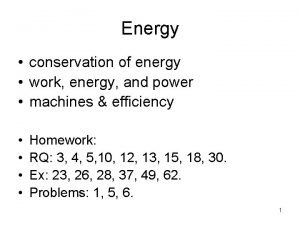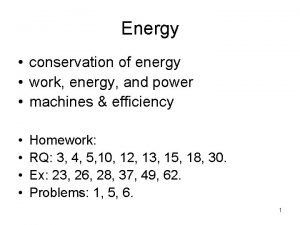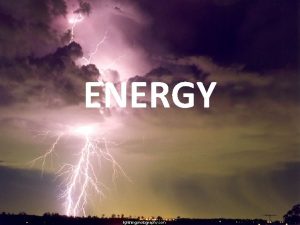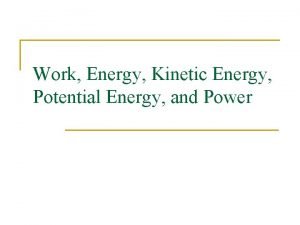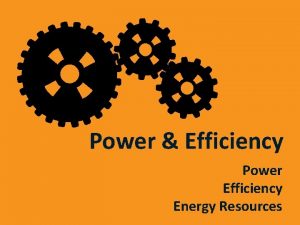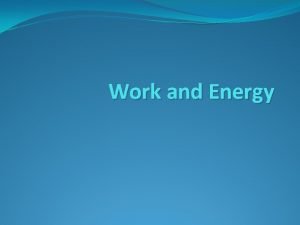Work Power Energy Work Concepts Work W is















- Slides: 15

Work, Power, Energy

Work Concepts • Work (W) is the product of the force exerted on an object and distance the object moves in the direction of the force. – W is transfer of energy by mechanical means. – W is done on an object only if it moves in the direction of the force. – Only the component of the force in the direction of the motion does work. – Force and displacement vectors must be parallel for work to be done.

Work Formulas Work = Force x displacement F W = F*d d 1 joule (J) = 1 Newton * meter (N * m) If force is exerted at an angle to direction of motion: W = (Fcos ) x d Or W = Fdcos( ) F d

Power • Power (P) is the rate at which work is done or rate at which energy is transferred. Measured in watts. – Watt (W) is one joule of energy transferred in one second. With units of…

Energy • • Often defined as the ability to do work. Measured in Joules Scalar quantity – direction does not matter There are many forms of energy but we will focus on Mechanical Energy for now. • Energy must be conserved. This is the fundamental law of the universe!

Mechanical Energy Any energy associated with a moving object or an object with the ability to start moving. Includes kinetic energy and potential energy • Kinetic Energy – energy an object has because it is in motion. – depends on mass and velocity • Potential Energy-Energy stored in an object • Could be stored due to its position (gravitational potential) OR • Could be stored due to its shape (elastic potential)

Mechanical Energy Mechanical energy is the energy which is possessed by an object due to its motion or its stored energy of position, shape, or form Mechanical Energy = K + U Where K = kinetic energy and U = potential energy

Kinetic Energy (K) • The energy an object has because of its motion. • Measured in Joules (J), which is equal to a Nm • Changes in velocity have a greater effect than changes in mass K = ½ x mass x velocity²

Potential Energy (U) Potential energy is the energy stored in an object because of its position, shape, or form

Gravitational Potential Energy (Ug) • the stored energy an object has due to its position (usually compared to its lowest point) • depends on the mass of an object, the gravitational field it is in, and the height of the object. • measured in Joules Grav. Pot. Energy = mass * gravity * height

Elastic Potential Energy (Uel) • energy an elastic object stores when it is stretched or compressed out of its original shape. • applies most commonly to springs, rubberbands, and bungee cords • Depends on “stiffness” of elastic material and how much it is stretched or compressed. • “k” is used to represent the “spring constant” or the “stiffness” of the material. It is measured in newtons per meter or N/m. (Note: not the same k as Kinetic energy K! Elastic potential energy = ½ * “spring constant” * (“stretch”)2 Where “k” is spring constant and “x” is the distance of stretch OR compression.

These concepts explained by cartoons Wile E Coyote and the Roadrunner

Work-Energy Theorem According to the Work-Energy theorem, the work done on an object, by the net force acting on it, is equal to the change in kinetic energy of the body Work = change in Kinetic Energy NOTE: Doing work on an object can also change the amount of potential energy an object has by the amount of work done. Example: 10 J of work is used to lift a box from the ground. That box now has 10 J of potential energy. Generally speaking…work equals the change in energy of an object!

Law of Conservation of Energy also known as the “fundamental law of the universe” Energy cannot be created or destroyed, it can only change forms. Since we are focusing on mechanical energy, the total mechanical energy (all forms added together) must remain constant at all times although it may change from potential to kinetic and back again. initial energy = final energy (K+ Ug + Uel)initial = (K + Ug + Uel)final Apply this equation to falling objects, rollercoasters, hot wheels, arrows shot upward, … almost anything really…and it will help you find what you need!

Efficiency • Ratio of work output to work input expressed in percent. • Ratio of final energy to initial energy expressed as percent • The percentage of work or energy put into a system that stays with the system and is NOT lost to heat. efficiency = (Wout / Win) * 100 Or efficiency = (Ef / Ei)*100
 Real power formula
Real power formula Energy energy transfer and general energy analysis
Energy energy transfer and general energy analysis Energy energy transfer and general energy analysis
Energy energy transfer and general energy analysis 0kei0
0kei0 Work, power and energy activities
Work, power and energy activities Joule units
Joule units Physics 2204 unit 3: work, power, energy
Physics 2204 unit 3: work, power, energy Work done define
Work done define How are energy work and power related
How are energy work and power related Work power energy and machines
Work power energy and machines F d cos theta
F d cos theta Work power
Work power Work energy power equations
Work energy power equations Unit 7 work energy and power answers
Unit 7 work energy and power answers Work energy
Work energy Chemical potential energy images
Chemical potential energy images




